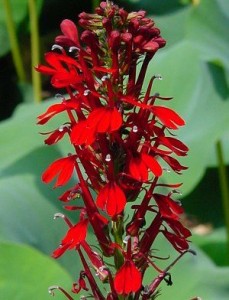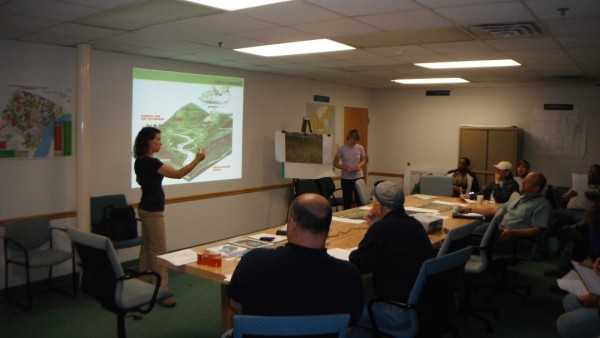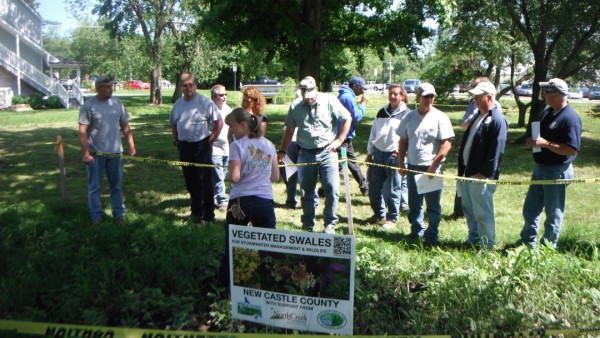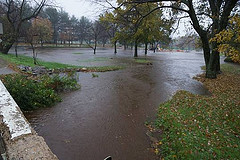Keeping our water safe and clean can sometimes be a bit of a challenge, especially when it comes to limiting the risk of pathogens. Most of us have heard the word pathogen before, and it probably reminds us of being sick, right? Pathogens are different types of bacteria, viruses, and parasites that can also contaminate and sicken drinking water sources, just like they do to us. Cryptosporidium (or “Crypto” for short) is a common waterborne pathogen.
Reduce Runoff; Slow It Down, Spread It Out, Soak It in! Swift Park Vegetated Swales.
 With the help of New Castle County workers and numerous volunteers, Swift Park, located in Hockesssin, Delaware off of Old Lancaster Pike, now has two vegetated swales leading to a small tributary of the White Clay Creek. Vegetated swales are a type of BMP (Best Management Practice) as stated by the EPA (Environmental Protection Agency) and serve many purposes, its biggest contribution being to help better manage the stormwater runoff that can contaminate your drinking water.
With the help of New Castle County workers and numerous volunteers, Swift Park, located in Hockesssin, Delaware off of Old Lancaster Pike, now has two vegetated swales leading to a small tributary of the White Clay Creek. Vegetated swales are a type of BMP (Best Management Practice) as stated by the EPA (Environmental Protection Agency) and serve many purposes, its biggest contribution being to help better manage the stormwater runoff that can contaminate your drinking water.
What's the big deal? Water is everywhere. In fact, the earth is comprised of over 70% water. The problem, less than 1% of that is safe drinking water! This is where BMPs and stormwater management become incredibly important to protecting water quality and quantity, not only for today, but for future generations.
The swales at Swift Park were originally installed to help with stormwater runoff coming from the impermeable surface area of the paved parking lot adjacent to Mill Creek. The original swales were lined in turf grass and mowed on a regular basis, with the main function being to convey water away from the parking area and into the creek. While this is good for parking, this does little to help with water quality. A better way to use these swales is to vegetate them with a native plant community, and that is what the White Clay Wild and Scenic Program, along with New Castle County, North Creek Nurseries, and funding from Delaware Department of Natural Resources and Environmental Conservation (DNREC) set out to do this past year.
The primary goal of the swales, as stated earlier, is to convey stormwater, but they can also function to help slow down, spread out, and soak in stormwater runoff from smaller, more typical rain events. They were not created to manage the larger storm events we have seen in recent years, such as Hurricane Sandy (seen below, pre-planting). However, newly vegetated, the swales are now trapping some of the sediment (dirt and debris) that would have ordinarily made its way directly into the creek as well as filtering out some of the nutrients.
Prior to these swales being installed, the water would sweep debris, chemicals, and anything in its path off the roads and parking lot, through the grass, and eventually into the creek, where it can pollute your drinking water. Now, during smaller, more common rain events of 1" or less, water runs into the swales, is slowed down by the vegetation, and the same polluted runoff has a better chance of infiltrating the ground. The native plants in turn help filter and infiltrate the water before it reaches the creek. This may seem like a small contribution to water quality improvement, and in commercial areas where there is more development and impervious surface coverage, it is difficult to completely control stormwater runoff. But every little thing we do adds up, and one easy way we can all better manage stormwater is by utilizing green infrastructure (native plant based BMPs) that can be as simple as a vegetated swale or small rain garden on your own property.

As if water quality wasn't enough, vegetated BMPs support native wildlife by providing habitat refuges. Native plants provide food and shelter for many species of animals. They do all this, and with proper care can also be beautiful landscapes! These swales in particular have many native plants that should begin blooming with in the first growing season, such as Lobelia cardinalis (Cardinal flower) seen blooming to the right which attracts hummingbirds with its shocking red, tubular flowers. You can find a full plant list used at Swift Park at the bottom of the page. Soon enough, the swales will be completely filled in with the native plants that are sure to be more attractive to park goers and wildlife alike; at the same time helping to improve your drinking water, little by little.
Native Plant List for Swift Park Swales:
Creek sedge (Carex amphibola)
Emory’s sedge (Carex emoryi)
Turtlehead (Chelone glabra)
Hot lips turtlehead (Chelone lyonii 'Hot Lips’)
Tufted hairgrass (Deschampsia cespitosa)
Hardy ageratum/ Eupatorium (Eupatorium coelestinum)
Blue flag iris (Iris versicolor)
Soft rush/ Poverty rush (Juncus effuses/ Juncus tenuis)
Spike gayfeather (Liatris spicata)
Cardinal flower (Lobelia cardinalis)
Great blue lobelia (Lobelia siphilitica)
Virginia bluebells (Mertensia virginica)
Eastern bee balm (Monarda bradburiana)
Obedient plant 'Pink manners' (Physostegia v. 'Miss Manners')
Appalachian mountain mint (Pycnanthemum muticum)
Golden groundsel (Senecio aureus)
Fireworks goldenrod (Solidago rugosa 'Fireworks')
For more on native plant suggestions, click here.
To view photo gallery from project, click here.
-article written by Ed Trommelen, summer intern 2013
To learn more about stormwater BMP's check out the video below created by the EPA.
New Castle County Hosts BMP Maintenance Workshop.

On Wednesday, June 18, New Castle County hosted a Best Management Practice (BMP) Maintenance Workshop for employees charged with managing and maintaining the BMPs throughout the County. More than 20 New Castle County employees attended the three hour workshop which consisted of an in-class segment, followed by a hands-on component at a recently installed BMP. The workshop was presented by Shane Morgan, White Clay Creek National Wild and Scenic Rivers Program Manager, and Claudia West, MLA, Ecological Sales Specialist for North Creek Nurseries. This was a pilot workshop, the first in a series of programs we hope to offer to employees of municipal governments, government representatives, landscape contractors, home owner associations, and other organizations interested in learning about why and how we install BMPs, how they function to improve water quality, and how to maintain them so that they operate successfully.

The workshop began with an overview of what a watershed is an how water moves through the landscape, connecting what we do on land with the impact our actions have on water quality and quantity. A more in depth discussion of how plant based BMPs function and look throughout different stages of establishment and seasons, and how to successfully maintain these systems followed. Questions were taken from the attendees in advance of the workshop so that it could be specifically tailored to the needs and concerns of the county employees.

The second part of the workshop took place at a newly installed vegetated bioswale in Hockessin, DE. The group learned how to monitor planted systems and identify problematic invasive plant species in the field. These skills are essential for proper management and the long term success of stormwater management landscapes.
While this workshop focused on municipal owned BMPs, it's equally important that the public understands that best management practices are not limited to government agencies responsible for meeting water quality standards. These practices are just as applicable to individual property owners as well. We all live in a watershed and any individual action taken to improve water quality however small it may seem, whether it's disconnecting a downspout and installing a rain barrel or rain garden, collectively adds up. If we begin to treat stormwater as a resource, instead of the nuisance we currently perceive it to be, together we can accomplish a lot.


